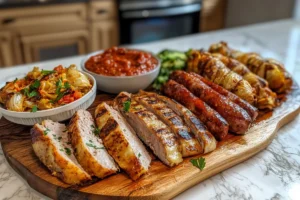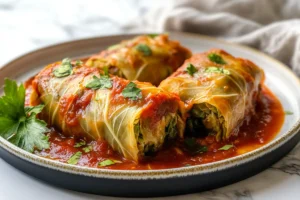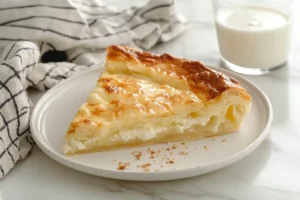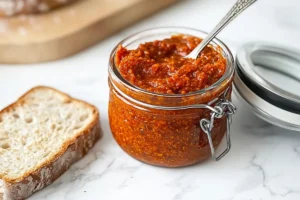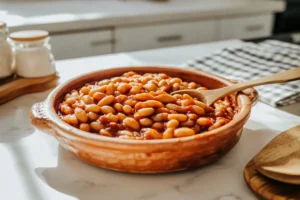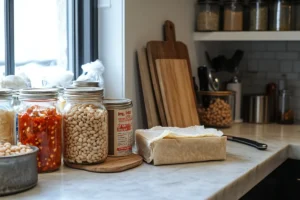What Is Traditional Balkan Food?
Hi, I’m Sylvia—creator of Dawnrecipes.com, and I’m so glad you’re here.
Let’s dive right into today’s question: What is traditional Balkan food? It’s one of the most flavorful, hearty, and deeply rooted cuisines you’ll ever come across. If you’ve never tasted Balkan dishes before, you’re in for something truly special.
Balkan food comes from a region that stretches across Southeast Europe. Countries like Serbia, Bosnia, Croatia, and North Macedonia all bring their own twist, yet share many comforting ingredients and age-old cooking methods.
I fell in love with Balkan food in my grandmother’s kitchen in Brooklyn. Her dishes were always simple but full of flavor. I remember the smell of roasted peppers, warm dough, and simmering stews filling her tiny kitchen. She didn’t follow fancy steps—just honest, home-style cooking that made you feel cared for.
So why does this food matter? Because it’s not just about recipes—it’s about tradition, community, and family. These meals are passed down through generations, carrying stories and memories with every bite.
And that’s what we’re exploring here today. Whether you’re just curious or ready to cook, this guide will help you understand what makes Balkan food so unique—and so irresistible.
Main Discussion – What Is Traditional Balkan Food?
So, let’s really answer the question: What is traditional Balkan food? At its heart, it’s comfort food—simple ingredients cooked slowly and lovingly, often shared around a big table with family.
What Makes Balkan Food Unique?
The Balkans are a mix of cultures—Turkish, Greek, Slavic, and Mediterranean influences all blend into one flavorful tradition. Yet, Balkan food stands on its own.
Here’s what sets it apart:
- Bold spices, but not overly spicy – Think paprika, garlic, dill, and bay leaves.
- Slow cooking methods – Stews, baked casseroles, and grilled meats are common.
- Fresh, seasonal ingredients – Peppers, tomatoes, cabbage, potatoes, and dairy products play a big role.
- Simple, hearty flavors – Nothing fancy, just rich taste from everyday ingredients.
7 Tasty Must-Try Balkan Dishes
Here are some of my favorite traditional Balkan foods you need to try:
- Ćevapi (Grilled Sausages) – Little skinless sausages made from minced meat, often served with flatbread, chopped onions, and sour cream.
- Sarma (Stuffed Cabbage Rolls) – Ground meat and rice wrapped in cabbage leaves, slowly cooked in a tomato-based sauce.
- Burek (Savory Pastry) – Flaky phyllo dough filled with meat, cheese, or spinach. It’s crispy on the outside and soft inside.
- Gibanica (Cheese Pie) – A layered pastry filled with eggs, feta cheese, and yogurt—comforting and filling.
- Ajvar (Pepper Spread) – Roasted red pepper and eggplant spread, perfect with bread or grilled meats.
- Musaka (Layered Potato Casserole) – Similar to Greek moussaka, but often made with potatoes instead of eggplant.
- Tavče Gravče (Baked Beans) – A North Macedonian classic: white beans baked with onions, spices, and oil in a clay dish.
Cultural Meaning Behind These Dishes
Each of these dishes tells a story. In my family, Sarma was always a Sunday meal. We’d gather in my grandma’s kitchen, rolling cabbage leaves together like a little assembly line.
These meals aren’t just for eating—they’re for gathering, celebrating, and connecting. And that’s what makes traditional Balkan food more than just food. It’s a living tradition passed down through generations.
Step-by-Step Insights / Actionable Advice
Let’s go beyond the question “What is traditional Balkan food?” and talk about how you can bring those authentic flavors into your kitchen—without getting overwhelmed.
Even if you already have a main recipe post, these tips and techniques will help you elevate your Balkan dishes or try something new with confidence.
Key Ingredients You Should Always Have on Hand
Here’s a quick list of Balkan pantry staples I keep in my own kitchen:
- Paprika (both sweet and smoked)
- Onions and garlic
- Pickled vegetables (especially cabbage and peppers)
- White beans
- Phyllo dough (frozen is perfectly fine!)
- Feta cheese
- Yogurt or kefir
- Ground beef or lamb
- Olive oil and sunflower oil
These simple ingredients form the base of most traditional Balkan food recipes. With just these, you can prepare a variety of dishes.
Practical Tips from My Kitchen
I’ve learned a few tricks over the years—mostly from watching my grandmother work with no measuring cups and a lot of intuition.
Try these tips to get that true Balkan flavor:
- Toast your paprika: A quick sizzle in oil brings out deep flavor. Add it after onions but before liquids.
- Layer your flavors slowly: Many dishes use the same ingredients, but what matters is the order—start with aromatics, then build.
- Don’t rush the dough: Whether it’s for Burek or Gibanica, let your dough rest so it becomes tender and easy to work with.
- Use broth instead of water: For stews or baked dishes, broth adds a richer base flavor.
Sylvia’s Shortcut Suggestions
I know life gets busy. Here’s how I simplify Balkan cooking without sacrificing taste:
| Traditional Method | Sylvia’s Simple Swap |
|---|---|
| Homemade phyllo dough | Store-bought frozen phyllo sheets |
| Fresh roasted peppers | Jarred roasted red peppers |
| Long-simmered beans | Canned white beans (rinsed well) |
| Homemade broth | Low-sodium boxed broth |
Even with shortcuts, you can still honor the heart of traditional Balkan food. It’s not about perfection—it’s about flavor, comfort, and sharing what you’ve made with people you love.
Personal Kitchen Memories
If you’ve ever wondered, what is traditional Balkan food, I can tell you—it’s more than just what’s on the plate. For me, it’s about moments in the kitchen that stay with you for a lifetime.
I grew up in Brooklyn, but my heart was often in the Balkans—thanks to my grandmother. Her kitchen was small, a little worn, and always warm. The smell of garlic sizzling in oil, dough rising under a cloth, and peppers roasting on the stove—that’s where my love of cooking began.
Cooking Was a Family Ritual
She didn’t own a recipe book. Everything she made came from memory and feel.
- I watched her roll out phyllo dough with just a broomstick handle.
- I helped her stuff cabbage leaves for Sarma, tucking them neatly just like she did.
- We’d stand over the stove, stirring beans or sauces, talking about life while the food cooked slow and steady.
These dishes weren’t just dinner—they were stories, shared across generations. That’s the magic behind traditional Balkan food—it’s homemade, humble, and full of meaning.
How These Memories Shape My Cooking Today
Even now, I cook the same way—with care, simplicity, and heart. I might use a few shortcuts today (hello, frozen phyllo), but the soul of the dish is still there.
And I hope that’s what you feel when you try these recipes too—not just taste, but connection. Because every time you cook something from the Balkans, you’re continuing a beautiful, old tradition.
Practical Tips for Everyday Cooks
Here’s how you can bring Balkan flavors into your home kitchen—without stress:
- Don’t be afraid of substitutions: Can’t find kefir? Use plain yogurt. No lamb? Ground beef works just fine.
- Make it ahead: Dishes like Sarma or Gibanica actually taste better the next day.
- Double your batches: Ajvar, stews, and casseroles freeze beautifully. Cook once, enjoy twice.
- Invest in basics: A good baking dish, sharp knife, and heavy pot will carry you through most Balkan recipes.
When to Stick to Tradition and When You Can Bend It
Some dishes are flexible, like Tavče Gravče—you can use canned beans and still get a great result. Others, like Burek, deserve a little extra time and care.
But don’t worry too much. If your filling spills a little or your phyllo tears, it’s still real traditional Balkan food—because it was made with intention and love.
Cultural Insights & Recipe Variations
Let’s explore the cultural layers behind the question: What is traditional Balkan food? Because food here isn’t just about taste—it’s about place, people, and history.
How Dishes Vary by Region
One thing I love about Balkan food is how every region—and even every household—puts its own spin on the same dish. What you eat in Serbia might look a little different in Bosnia or Macedonia, but the roots are the same.
Here’s a quick look at how some classic dishes vary:
| Dish | Regional Variation |
|---|---|
| Sarma | In Serbia, it’s heavier on smoked meats. In Bosnia, you’ll find it milder, often with rice-heavy filling. |
| Burek | In Bosnia, “Burek” means meat-filled only. In other areas, cheese or spinach versions are also called Burek. |
| Ajvar | Some regions roast their peppers darker for a smokier taste, while others add more eggplant or vinegar. |
| Gibanica | Some versions are fluffy and light, others dense and rich—depends on the ratio of egg to cheese. |
Everyday vs. Celebration Food
In my family, we had two kinds of meals: weekday comfort dishes and special occasion meals. For example:
- Weekday meals: Tavče Gravče, simple soups, or mashed potatoes with grilled meat.
- Celebration meals: Sarma, whole roasted meats, Gibanica, and homemade pastries.
Understanding these differences gives you a deeper appreciation of what traditional Balkan food really means—it’s a way of marking everyday life and special moments alike.
Modern Twists You Can Try
Want to make these dishes your own while staying true to tradition? Try these fun ideas:
- Make a vegetarian Sarma using mushrooms and lentils.
- Use puff pastry instead of phyllo for a quick Gibanica.
- Add chili flakes to Ajvar for a spicy edge.
FAQ – What Is Traditional Balkan Food?
I get a lot of questions from readers who are just starting to explore Balkan cooking. So let’s clear up a few common ones that come up when people first ask, what is traditional Balkan food?
Is Balkan food spicy?
Not usually. It’s full of flavor, but most dishes focus on paprika, garlic, and herbs—not heat. You can always add spice if you like it, but it’s not a core element.
Can I make these dishes vegetarian?
Absolutely. Many traditional dishes can be adapted:
- Use mushrooms or lentils in Sarma.
- Try cheese- or spinach-filled Burek.
- Tavče Gravče is naturally vegetarian (and full of protein).
What’s the best dish to start with if I’m new to Balkan cooking?
Start with Ajvar or Tavče Gravče. They’re simple, forgiving, and packed with flavor. Gibanica is also a great option—easy to assemble, and everyone loves it.
Where can I find Balkan ingredients?
Check international grocery stores or Eastern European markets. Many items like phyllo dough, feta cheese, and Ajvar are also available online or in the international aisle of major supermarkets.
How long do these dishes keep?
Most traditional Balkan food tastes better the next day. You can store:
- Sarma or stews – Up to 4 days in the fridge.
- Burek or Gibanica – 2 to 3 days refrigerated, or freeze for later.
- Ajvar – Lasts several weeks in a sealed jar in the fridge.

